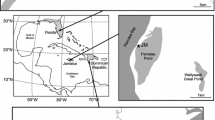Abstract.
Three shallow brackish water lagoons on the Baltic Sea coast of Germany were studied for ostracod (Crustacea) associations in macrophyte habitats. In order to assess the use of fossil ostracod valves for the reconstruction of Holocene submerged plant communities, we analysed living associations (biocoenosis) on, below and around macrophytes as well as dead valve assemblages (thanatocoenosis) around phytal habitats and on un-vegetated sediment surfaces. The salinity conditions cover the oligohaline to mesohaline range from about 3 psu in the Saaler Bodden to about 10 psu in the Salzhaff. Surprisingly, we found remarkably high numbers of living ostracods (mainly Xestoleberis aurantia and Loxoconcha elliptica) on characeans from the Barther Bodden only. The plants from other stations were generally barren of ostracods. Nevertheless, distinguishable ostracod associations live around submerged macrophytes across the studied salinity range. Exclusively phytal ostracod species seem to be lacking in β-oligohaline water, so ostracod valves from sediment cores can hardly be used as proxies for past macrophytal cover in this salinity range. Xestoleberis aurantia, X. nitida and Loxoconcha elliptica are the typical phytal ostracods in α-oligohaline and β-mesohaline water of the study area. We consider that they have potential to be used as indicators of past macrophytal habitats, but further studies are necessary to confirm this. The differentiation of specific plant communities by means of ostracod associations was not possible. In conclusion, we anticipate that a general, temporally and spatially averaged picture of past aquatic macrophyte distribution can be obtained by analysing ostracod valve assemblages from α-oligohaline and mesohaline waters in the Holocene of the southern Baltic Sea.
Similar content being viewed by others
Author information
Authors and Affiliations
Corresponding author
Additional information
Received: 28 April 2004; revised manuscript accepted: 12 October 2004
Rights and permissions
About this article
Cite this article
Frenzel, P., Henkel, D., Siccha, M. et al. Do ostracod associations reflect macrophyte communities? A case study from the brackish water of the southern Baltic Sea coast. Aquat. Sci. 67, 142–155 (2005). https://doi.org/10.1007/s00027-004-0756-z
Issue Date:
DOI: https://doi.org/10.1007/s00027-004-0756-z




